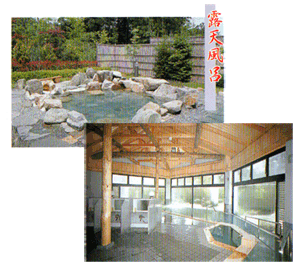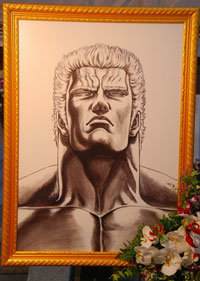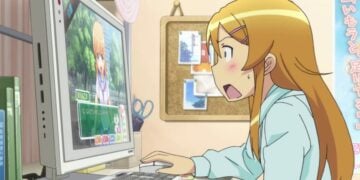As part of my son’s homework, he keeps a diary about the past day’s events, alternating entries between Japanese and English. It seems that every Sunday night’s entry is the same — he writes about what Japanese hot springs we went to that weekend. Japan is a very volcanic country, which means there are a lot of underground hot springs, or onsen (pronounced OWN-sen) to tap for bathing. Most every weekend we head out in our Mazda Bongo Friendee (sort of an MPV with a top that can be raised, like the old Volkswagon Vanagons) and enjoy a steaming hot bath somewhere in the mountains. Bathing in hot springs has been a part of Japan’s culture for centuries — one of the most famous onsen towns in Japan is Kusatsu (koo-SA-tsoo), located right in our prefecture, and it’s been known for its baths for the past eight hundred years. One of the small linguistic quirks of the Japanese language is that there are separate words for cold water (mizu) and hot water (yu), and gaijin will invariably use the wrong word, to the amusement of everyone here. Bathing is so important in Japan that the word yu commonly gets the honorific o attached to the front (e.g. o-yu), as a sign of respect.

Last weekend we picked a nice-looking onsen in a village called Showa-mura and headed up there. It wasn’t our first choice for a destination, but some of our regular hot spring spots are located high in the mountains, and we didn’t want to hassle with driving in snow. The facility, the Showa-no-yu General Welfare Center, was pretty much what we’d come to expect: a washing area where you clean your body before bathing; a good mix of indoor baths to choose from; an outdoor bath where you can take a dip while enjoying “vibrant greenery”; and a sauna. There was also a large common room where you can relax, have a beer and enjoy some karaoke or a game of go after your bath. Also as expected, the facility was built by the local municipal government and operated with tax money, rather than by a private company. From swimming pools to the Kampo life insurance sold by the post office to a chain of luxury hotels subsidized by postal savings accounts, there are dozens of areas where the Japanese government intrudes on the private sector, doing things that often could be done efficiently by regular companies. The overall effect of this interference by the government is that Japan is less of a market-driven country and closer to something like socialism, a fact born out by the extremely low rate of entrepreneurship here. On the one hand, I’m happy to have access to a nice, hot bath in a small village that probably couldn’t support such a venture without public money, but on the other hand, I wonder if Japan’s public works-based approach to driving the country forward can be sustained.
Pocky has gone from being a wonky snack that a few anime fans knew about to being a major force in the world-wide snack market. The chocolate-covered pretzel stick, named for the pokki! sound they make when you break one, was first introduced in 1965, by Glico, a confectionery company founded by a man who swore to improve the health of Japan’s children by introducing sweets containing glycogen harvested from oysters (which is where the name Glico comes from). There are many different flavors of Pocky available, from traditional chocolate to slightly bitter Men’s Pocky to the luxurious line of Pocky that look like decorated cakes and even the surprise of the season, Black Sesame Pocky. Now Glico has introduced two new varieties of thick Mousse Pocky for 2006: Murasaki Imo (a purple-colored sweet made with sweet potato), and a favorite of J-List customers, the new Green Tea Mousse Pocky! In addition to being just plain delicious, the new Mousse Pocky boxes are some of the most beautifully-designed I’ve ever seen, with amazing traditional Japanese images on them. Sure to be a collector’s item in years to come — no B.S., I think I will save a case of each in a cool, dry place just in case it goes up in value someday. Available by the case, too!















